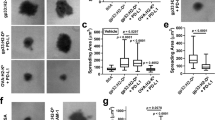Abstract
CD2 (known also as T11 (ref. 1), LFA-2 (ref. 2) and the erythrocyte rosette receptor (ref. 3)) is a functionally important T lymphocyte surface glycoprotein of relative molecular mass 50,000 to 58,0004 (Mr 50–58 K) which appears early in thymocyte ontogeny and is present on all mature T cells5. Monoclonal antibodies to CD2 inhibit cytotoxic T-lymphocyte (CTL)-mediated killing by binding to the T lymphocyte and blocking adhesion to the target cell2–4,6. Such antibodies also inhibit T helper cell responses including antigen-stimulated proliferation, interleukin-2 (IL-2) secretion, and IL-2 receptor expression2–4,7–9. Certain combinations of monoclonal antibodies to CD2 epitopes trigger proliferation of peripheral blood T lymphocytes1, cytotoxic effector function10 and expression of IL-2 receptors by thymocytes, resulting in thymocyte proliferation in the presence of exogenous IL-2 (ref. 11). These findings suggest that CD2 can function in signalling as well as being an adhesion molecule. To understand the role of CD2 in T-cell adhesion and activation, it is essential to define its natural ligand. Our previous observation that purified CD2 inhibits resetting of T lymphocytes with sheep erythrocytes and can be absorbed by sheep erythrocytes12 suggested it also might bind with detectable affinity to human cells. We now report that CD2 binds to a cell-surface antigen known as lymphocyte function-associated anti-gen-3 (LFA-3) with high affinity, and can mediate adhesion of lymphoid cells via interaction with LFA-3.
This is a preview of subscription content, access via your institution
Access options
Subscribe to this journal
Receive 51 print issues and online access
$199.00 per year
only $3.90 per issue
Buy this article
- Purchase on Springer Link
- Instant access to full article PDF
Prices may be subject to local taxes which are calculated during checkout
Similar content being viewed by others
References
Meuer, S. C. et al. Cell 36, 897–906 (1984).
Sanchez-Madrid, F. et al. Proc. natn. Acad. Sci. U.S.A. 79, 7489–7493 (1982).
Van Wauwe, J., Goossens, J., Decock, W., Kung, P. & Goldstein, G. Immunology 44, 865–871 (1981).
Krensky, A. M. et al. J. Immun. 131, 611–616 (1983).
Haynes, B. F. Immun. Rev. 57, 127–161 (1981).
Krensky, A. M., Robbins, E., Springer, T. A. & Burakoff, S. J. J. Immun. 132, 2180–2182 (1984).
Palacios, R. & Martinez-Maza, O. J. Immun. 129, 2479–2485 (1982).
Reed, J. C., Tadmori, W., Kamoun, M., Koretzky, G. & Nowell, P. C. J. Immun. 134, 1631–1639 (1985).
Tadmori, W., Reed, J. C., Nowell, P. C. & Kamoun, M. J. Immun. 134, 1709–1716 (1985).
Siliciano, R. F., Pratt, J. C., Schmidt, R. E., Ritz, J. & Reinherz, E. L. Nature 317, 428–430 (1985).
Fox, D. A. et al. J. Immun. 134, 330–335 (1985).
Plunkett, M. L. & Springer, T. A. J. Immun. 136, 4181–4187 (1986).
Selvaraj, P., Plunkett, M. L. & Springer, T. Biochim. biophys. Acta (submitted).
Springer, T. A., Mann, D. L., DeFranco, A. L. & Strominger, J. L. J. biol. Chem. 252, 4682–4693 (1977).
Shaw, S. et al. Nature 323, 262–264 (1986).
Vollger, L. W., Tuck, D. T., Springer, T. A., Haynes, B. F. & Singer, K. H. J. Immun. 138, 358–363 (1987).
Rothlein, R., Dustin, M. L., Marlin, S. D. & Springer, T. A. J. Immun. 137, 1270–1274 (1986).
Rothlein, R. & Springer, T. A. J. exp. Med. 163, 1132–1149 (1986).
Krensky, A. M. et al. Hybridoma Technology in the Biosciences and Medicine (ed. Springer, T. A.) 559–573 (Plenum, New York and London, 1985).
Barbosa, J. A. et al. J. Immun. 136, 3085–3091 (1986).
Springer, T. A., Dustin, M. L., Kishimoto, T. K. & Marlin, S. D. A. Rev. Immun. 5 (in the press).
Plunkett, M. L., Sanders, M. E., Selvaraj, P., Dustin, M. L. & Springer, T. A. J. exp. Med. (in the press).
Makgoba, M. W., Shaw, S., Gugel, E. A. & Sanders, M. E. J. Immun. (submitted).
Hünig, T. J. exp. Med. 162, 890–901 (1985).
Dustin, M. L., Sanders, M. E., Shaw, S. & Springer, T. A. J. exp. Med. (in the press).
Haynes, B. F. Clin. Res. 34, 422–431 (1986).
Barnstable, C. J. et al. Cell 14, 9–20 (1978).
Iida, K., Mornaghi, R. & Nussenzweig, V. J. exp. Med. 155, 1427–1438 (1982).
Morrissey, J. H. Analyt. Biochem. 117, 307–310 (1981).
Scatchard, G. Ann. N.Y. Acad. Sci. 51, 660–672 (1949).
Fraker, P. J. & Speck, J. C. Biochem. biophys. Res. Comm. 80, 849–857 (1978).
Author information
Authors and Affiliations
Rights and permissions
About this article
Cite this article
Selvaraj, P., Plunkett, M., Dustin, M. et al. The T lymphocyte glycoprotein CD2 binds the cell surface ligand LFA-3. Nature 326, 400–403 (1987). https://doi.org/10.1038/326400a0
Received:
Accepted:
Issue Date:
DOI: https://doi.org/10.1038/326400a0
This article is cited by
-
rs10924104 in the expression enhancer motif of CD58 confers susceptibility to human autoimmune diseases
Human Genetics (2024)
-
Promise and challenges of clinical non-invasive T-cell tracking in the era of cancer immunotherapy
EJNMMI Research (2022)
-
IFN signaling and neutrophil degranulation transcriptional signatures are induced during SARS-CoV-2 infection
Communications Biology (2021)
-
Large-scale site-specific mapping of the O-GalNAc glycoproteome
Nature Protocols (2020)
-
Memory T cells in organ transplantation: progress and challenges
Nature Reviews Nephrology (2016)
Comments
By submitting a comment you agree to abide by our Terms and Community Guidelines. If you find something abusive or that does not comply with our terms or guidelines please flag it as inappropriate.



